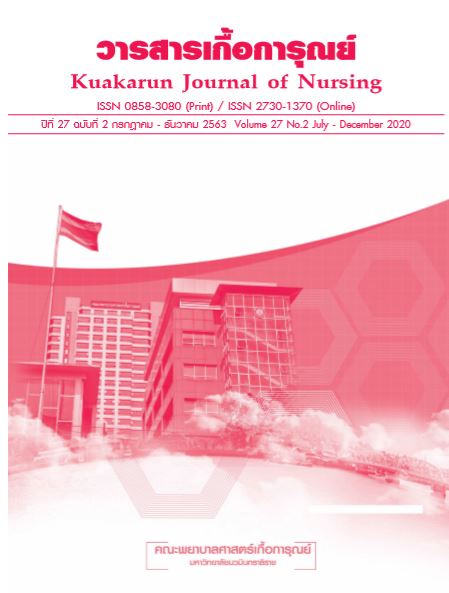ความสามารถในการปฏิบัติกิจวัตรประจำวันของผู้สูงอายุ ในกรุงเทพมหานคร
คำสำคัญ:
ความสามารถในการดำเนินชีวิต, ผู้สูงอายุบทคัดย่อ
การวิจัยเชิงพรรณนาครั้งนี้มีวัตถุประสงค์เพื่อ 1) ประเมินความสามารถในการดำเนินชีวิตในสังคมของผู้สูงอายุในชุมชนเมือง 2) เปรียบเทียบระดับความสามารถในการปฏิบัติกิจวัตรประจำวันของผู้สูงอายุระหว่าง เพศ อายุ สถานภาพการสมรส ระดับการศึกษา และรายได้ 3) วิเคราะห์ปัจจัยที่ส่งผลต่อความสามารถในการปฏิบัติกิจวัตรประจำวันของผู้สูงอายุ คัดเลือกกลุ่มตัวอย่างแบบแบ่งชั้นภูมิกลุ่มผู้สูงอายุในเขตกรุงเทพมหานครที่มีภูมิลำเนาอยู่ในชุมชนประเภทต่าง ๆ ดังนี้ 1) ชุมชนแออัด 2) ชุมชนเมือง 3) ชุมชนชานเมือง และ 4) ชุมชนอาคารสูงรวมทั้งสิ้นจำนวน 888 คน เครื่องมือที่ใช้ในการวิจัยคือ แบบสอบถามข้อมูลทั่วไป และแบบประเมินความสามารถในการปฏิบัติกิจวัตรประจำวัน ดัชนีบาร์เธล เอดีแอล ทำการเก็บรวบรวมข้อมูลโดยการสัมภาษณ์ วิเคราะห์ข้อมูลด้วยสถิติเชิงพรรณนา การวิเคราะห์ความแปรปรวน การวิเคราะห์ต่อด้วยวิธีการของดันแคน
ผลการวิจัยพบว่า มากกว่าร้อยละ 90 ของผู้สูงอายุสามารถปฏิบัติกิจวัตรประจำวันได้ดีด้วยตัวเอง ทั้งกิจกรรมพื้นฐานและกิจกรรมที่ซับซ้อน ในเรื่องการกลั้นอุจจาระและปัสสาวะพบว่า 8 ใน 10 ของผู้สูงอายุสามารถทำได้ดีด้วยตัวเอง แต่ในกลุ่มผู้สูงอายุในชุมชนเมืองพบว่ามีปัญหาในเรื่องนี้มากที่สุด นอกจากนี้ยังพบว่า ความสามารถในการซื้อของ การจ่ายตลาด และการใช้บริการระบบขนส่งสาธารณะในชุมชนชานเมืองจะน้อยกว่าชุมชนอื่น ๆ เมื่อพิจารณาตัวแปรพบว่า เพศ สถานภาพสมรส ระดับการศึกษาไม่มีผลต่อการปฏิบัติกิจวัตรประจำวันของผู้สูงอายุ รายได้และอายุส่งผลต่อความสามารถในการปฏิบัติกิจวัตรประจำวัน โดยกลุ่มที่มีรายได้สูงกว่ามีแนวโน้มที่จะปฏิบัติกิจวัตรประจำวันได้ดีกว่าอย่างมีนัยสำคัญทางสถิติ (p < .05) เมื่อเปรียบเทียบความสามารถในกลุ่มอายุ พบว่ากลุ่มผู้สูงอายุที่มีอายุ 80 ปีขึ้นไป ความสามารถในการปฏิบัติกิจวัตรประจำวันทำได้น้อยกว่ากลุ่มที่มีอายุน้อยกว่าอย่างมีนัยสำคัญทางสถิติ (p < .05) ข้อเสนอแนะจากผลวิจัยครั้งนี้คือ ภาครัฐควรเพิ่มสวัสดิการและเบี้ยยังชีพให้แก่กลุ่มผู้สูงอายุ และควรมีการวางแผนร่วมกันระหว่างทีมสุขภาพและผู้ดูแลผู้สูงอายุในการจัดกิจกรรมเพื่อให้ผู้สูงอายุที่อายุเพิ่มขึ้นสามารถปฏิบัติกิจวัตรประจำวันได้ดีดังเดิม
เอกสารอ้างอิง
National Statistical Office. Thai elderly 2007 perspectives / reflections from statistical data. Bangkok: PA Living; 2008. (in Thai)
Wongboonsin K. Aging society (Elderly). Bangkok: Chulalongkorn University Printing House; 2008. (in Thai)
Sattayatorn P. Maternal and infant health network for families, children and youth [Internet]. 2010 [cited 2017 Feb 8]. Available from: http://mchnetwork.thaihealthykids.com (in Thai)
Jayant M, Anna MN. Aging in Asia: trends, impacts and responses [Internet]. 2009 [cited 2018 Mar 25]. Available from: http://aric.adb.org/pdf/workingpaper/WP25_Aging_in_Asia.pdf
United Nation. World Population Aging 2016. New York: United Nations; 2016.
Karuncharernpanit S. The relationships between balance, activities of daily living and cognitive function of older people in Ban Pong District, Ratchaburi Province. Thai Journal of Nursing 2014;63(4):20-8. (in Thai)
Yamwong N. Quality of life and physical activities of daily living among elderly patients at HRH Princess Maha Chakri Sirindhorn Medical Center. Journal of Medicine and Health Sciences 2014;21(1):37-44. (in Thai)
Supurairat C, Jai-aree A, srisuantang S. Factors related to the ability to perform daily activities of the elderly in tambon Huaykwang, Ampeo Kamphaeng Saen, Changwat Nakhonpathom. The Journal of the Veridian E-Journal, Silpakorn University 2014;7(2):187-202. (in Thai)
Buakaew P, Teungfung R. Health care and health status of Thai aging. Journal of the Association of Researchers 2016;21(2):94-109. (in Thai)
National Statistical Office. A compilation of important statistics for Thailand. Bangkok: Statistical Data Integration Group; 2008. (in Thai)
Office of Social Development. Bangkok metropolis announcement in accordance with the community committee. Bangkok: Prigwan Graphic; 2012. (in Thai)
Ministry of Public Health, Department of Medical Services. Standard manual and clinical practice for quality elderly. Bangkok: Institute of Geriatric Medicine; 2014. (in Thai)
SAS Institute. SAS® 9.x Install Center [Internet]. 2020 [cited 2018 Aug 18]. Available from: https://support.sas.com/documentation/installcenter/913/index.html
Foundation of Thai Gerontology Research and Development Institute. Situation of Thai elderly. Nakhon Pathom: Printery; 2016. (in Thai)
Oba N. Mental status activities and activities of daily life and among Thai elderly in rural Area. Journal of Nursing and Health Science 2015;9(1):17-30. (in Thai)
Pothiban L, Wathisunthon M, Pan-uthai S. Development of the older people dependency screening tool for village health volunteers. Bangkok: Foundation of Thai Gerontology Research and Development institute; 2010. (in Thai)















